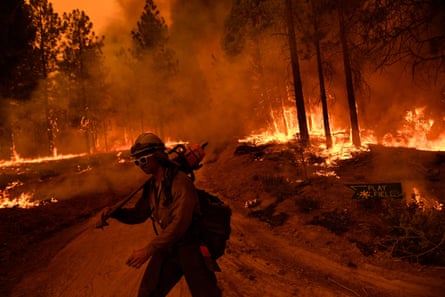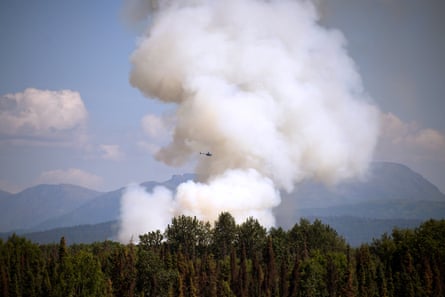Alaska has seen more than 500 forest fires since the beginning of April, which have forced the evacuation of mining camps, villages and remote cabins.
By 15 June, more than 1m acres (405,000 hectares) in the state had already gone up in flames, about the amount of acres that would normally burn in an entire fire season. By mid-July, more than 3m acres of land had been torched, putting the state at risk of breaking its 2004 record of 6.5m acres (2.6m hectares) burned.
Today 264 individual fires are burning across the state. The East Fork complex, which ignited in western Alaska on 31 May, and the Lime complex fire above Bristol Bay, have already destroyed more than 1m acres. Satellite photos show rust-red scars trailing wisps of smoke in the west and south-west parts of the state, where fires continue to smolder. May and June set records in Alaska for dryness.
“It’s unprecedented,” said Rick Thoman, a climate specialist at the International Arctic Research Center in Fairbanks, of this year’s fires.
Experts like Thoman attribute the burn to two factors: an unusual amount of lightning strikes causing ignitions, and a landscape primed to burn.
“Drought, early melt of snowfall, winds and lightning strikes have all combined to make for a tough start to the season,” Thoman said.
The high number of lightning strikes is a result of increased vapor in the relatively warmer air across the state, which in turn has increased the number of thunderstorms, Thoman explained.
Over a four-day span in July, for example, almost 40,000 lightning hits were recorded across the state, while Alaska averages about 60,000 strikes over the course of a year.
The strikes connected with a landscape ready to burn. Willows and alders in the state’s forests have grown thicker and taller, while black spruce, another tree common in the forests, grow larger and work up the hills. Meanwhile, warmer temperatures have increased vegetation on the tundra. “At the end of the day, you just have more material to burn,” Thoman said.

The climate crisis is playing a part in the changing conditions, Thoman said. “It’s not only Alaska. Across the board in the Arctic and the sub-Arctic, you’re seeing this increase in fires. Taking into consideration the lightning, the drought, the early snowmelt – there’s just no doubt the warming planet is playing a huge role in this.”
Sam Harrel, information officer at the Alaska Division of Forestry and Fire Protection, said he couldn’t recall such a drastic year of firefighting in the state. “These lightning storms are relentless. You’ve got the early melting snowpack, and dead grass on the tundra. One strike and the dead grass goes up like tinder.”
Long fingers of fire
The increase in flammable vegetation is creating fires that are “way more intense”, said Kale Casey, the lead information officer for Alaska Incident Management Green Team, which helps coordinate responses to fires across the state. Fires this year are causing a burn Casey said he hasn’t seen in his 17 years of working in fire suppression.
“Rather than running through the trees and just scorching the earth, these guys are burning deep, getting everything,” he said.
Casey and his firefighters have also noticed what he described as “long fingers of fire” burning deep into the tundra.
Instead of working quickly across the “duff layer”, the dense maps of grass and shrubbery decomposing along the top of the soil, today’s fires often burn through the duff to the mineral soil beneath, explained Zav Grabinski, a science communicator at the Alaska Fire Science Consortium, a wildfire research center.
“If the fire burns through the duff and reaches mineral soil that’s the sign of a very hot and deep fire,” Grabinski said. “This year’s duff is bone dry, creating these burns. In a usual year without drought, you can dig down and find moisture pretty quickly.”

Deeper fires can also mean more resilient coals. Embers nest in the duff, insulated over the long winter from snow, feeding on flammable peat. Come spring, winds cause the embers to flare back up, creating holdover fires – or what firefighters call “zombie fires”.
“With fires burning hotter, and burning deeper into the forest floor, we’ve seen that multiple times,” Casey said. “The fire augurs in there, then wakes up again. That’s always discouraging.”
Casey said that zombie fires might be responsible for some of the early fires the state saw in April.
Smoke and destruction
One of the longest-burning fires haunting the state is the Upper Talarik fire, part of what is now known as the Lime fire complex, not far from the proposed site for the controversial Pebble mine, one of the world’s largest open-pit gold and copper mines.
On 30 June, the Upper Talarik fire destroyed a supply camp for Pebble Partnership, the conglomerate vying to build the mines. A charred mess of twisted augurs and skeletons of Quonset huts was all the fire left in its wake.
Due to Alaska’s large size and small population density, fires have only prompted a handful of community evacuations. Homeowners in Anderson, a town located about 80 miles (129 km) south-west of Fairbanks, were told to “take your family and pets and leave now”. At least one home has burned in the area, though officials cannot confirm an exact number.

Among the other impacts has been smoke pollution. Harrel pointed at the East Fork fire, threatening the community of Saint Mary’s on the Yukon River, and Pitkas Point, just across from it. At one point, the smoke was so bad residents couldn’t see the banks on the other side of the river, Harrel said. People did yard work with respirators. Although the drought allowed residents to run ATVs up lower riverbeds instead of along bumpy trails along the bank, and the smoke kept away mosquitoes (Alaskans refer to the insects as the “state bird”), the fires limited solar panel production and threatened respiratory health.
The smoke causes headaches, burning eyes and bronchitis. This spring, a hospital in Nome, in western Alaska, recorded 600 parts per million of particulate matter. Doctors say that anything over 150 parts per million of particulate matter can damage the lungs and trigger asthma.
Seth Kantner, who grew up in a sod cabin on the Kobuk River near Kotzebue along Alaska’s western coast, and built his daughter a cabin 40 miles (64 km) up the Noatak, said he worries constantly about both structures burning in the encroaching Derby Creek fire, especially when he’s working on the ocean, as a commercial fisher. “There’s been very little rain since the snow melted in May. We’ve had sun, but not much precipitation. It’s nerve-racking, worrying about the fires.”
The new normal
While decades of poor forest management have contributed to a number of historical fires in California and the Pacific north-west, Alaska’s situation is different, Casey said. Over the years, most fires in the state had been left to burn because they are often so remote: “In Alaska we basically fight fires by aviation or boat. [The fires] are just so tough to get to,” he noted.
Today, a conglomeration of state and federal firefighters deployed by helicopter, parachute, boat and trucks, work with crews from other US states with the idea that the Alaska crews will reciprocate once the Alaska season wanes and fires intensify farther south. Airplanes nicknamed “Fire Bosses”, drop 800 gallons of water collected from lakes and rivers over the fires, allowing firefighters to create perimeters in an effort to stop the spread.
Still, Casey said, his crews are bracing for the months ahead.
“Here we are, the middle of July. Right now it could go a lot of different ways. 2009. 2004. We have all these memories of these years. In our careers, we hear the word ‘records’ more and more and more. We hope for rain. But as we all know in the trade, hope is not a strategy for fighting fire.”

Rick Halford, a former senate president of the Alaska legislature and air taxi operator who has witnessed fire seasons from his planes, said he has never seen a weather season so intense. “In Alaska, you had lightning and thunder so rarely that your kids were shocked by it,” Halford said. “It’s not that way any more. ”
Halford hopes for the heavy rains of late summer, but he has learned after more than half a century living in Alaska that depending on the weather is a risky prospect. As for the larger reason behind the increase in fires, he said that science confirms what he is able to see from the windows of his cockpit. “The fire seasons are getting worse, and that’s a fact,” he added.
“This may end up being our worst year. This is reflective of changes around the planet. Even if these fires aren’t generated by human action, they are still part of what we are changing on this Earth. Things are just getting warmer.”
Francis Mitchell, a former emergency firefighter and public information officer, said that people in his hometown, in McGrath, in south-west Alaska, have been fighting fire since the 1940s. He recalled that in the 1960s, a number of village civilian crews were “trained” to fight remotely. “The plane would show up, and you just got on and fought fire. That was your training.”
The spread of this year’s fires shocked him, he said. “It’s just not what we’re accustomed to seeing.”
